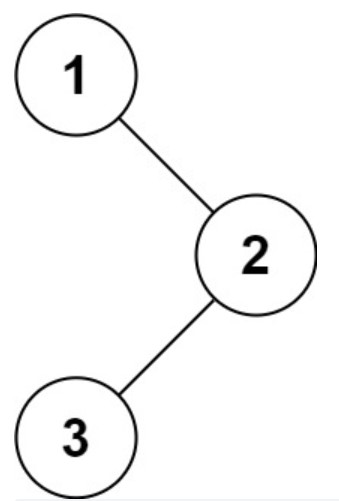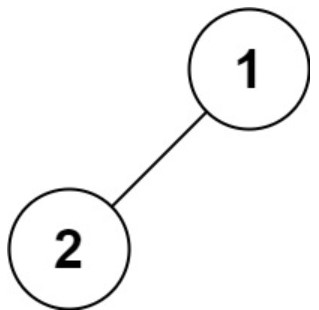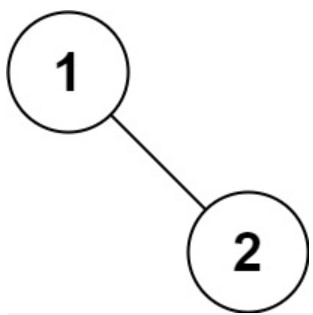题目
给你二叉树的根节点 root,返回它节点值的 前序 遍历。
示例 1:
输入:root = [1,null,2,3]输出:[1,2,3]
示例 2:
输入:root = []
输出:[]
示例 3:
输入:root = [1]
输出:[1]
示例 4:
输入:root = [1,2]
输出:[1,2]
示例 5:
输入:root = [1,null,2]
输出:[1,2]
提示:
- 树中节点数目在范围
[0, 100]内 -100 <= Node.val <= 100解题方法
递归
通过递归的方式前序遍历二叉树,终止节点为当前节点为空。
时间复杂度O(n),空间复杂度 平均:O(logn),最劣(链):O(n)
C++代码:/** * Definition for a binary tree node. * struct TreeNode { * int val; * TreeNode *left; * TreeNode *right; * TreeNode() : val(0), left(nullptr), right(nullptr) {} * TreeNode(int x) : val(x), left(nullptr), right(nullptr) {} * TreeNode(int x, TreeNode *left, TreeNode *right) : val(x), left(left), right(right) {} * }; */ class Solution { public: void pre_order(TreeNode* p, vector<int>& vec) { if(p!=NULL) { vec.push_back(p->val); pre_order(p->left, vec); pre_order(p->right, vec); } } vector<int> preorderTraversal(TreeNode* root) { vector<int> result; pre_order(root, result); return result; } };迭代
使用 栈 处理节点,将栈顶元素(父节点)压入数组后从栈中弹出,再将该节点的右、左节点依次压入栈中,重复该操作直至栈为空。
时间复杂度O(n),空间复杂度 平均:O(logn),最劣(链):O(n)
C++代码:/** * Definition for a binary tree node. * struct TreeNode { * int val; * TreeNode *left; * TreeNode *right; * TreeNode() : val(0), left(nullptr), right(nullptr) {} * TreeNode(int x) : val(x), left(nullptr), right(nullptr) {} * TreeNode(int x, TreeNode *left, TreeNode *right) : val(x), left(left), right(right) {} * }; */ class Solution { public: void pre_order(TreeNode* p, vector<int>& vec) { stack<TreeNode*> nodes; if(p!=NULL) nodes.push(p); while(nodes.size()>0) { TreeNode *tmp = nodes.top(); vec.push_back(tmp->val); nodes.pop(); if(tmp->right != NULL) nodes.push(tmp->right); if(tmp->left != NULL) nodes.push(tmp->left); } } vector<int> preorderTraversal(TreeNode* root) { vector<int> result; pre_order(root, result); return result; } };Morris遍历
记作当前节点为cur。
- 如果cur无左孩子,cur向右移动(cur=cur.right)
- 如果cur有左孩子,找到cur左子树上最右的节点,记为mostright
- 如果mostright的right指针指向空,让其指向cur,cur向左移动(cur=cur.left)
- 如果mostright的right指针指向cur,让其指向空,cur向右移动(cur=cur.right)
时间复杂度为O(n),空间复杂度为O(1)。
C++代码:
/**
* Definition for a binary tree node.
* struct TreeNode {
* int val;
* TreeNode *left;
* TreeNode *right;
* TreeNode() : val(0), left(nullptr), right(nullptr) {}
* TreeNode(int x) : val(x), left(nullptr), right(nullptr) {}
* TreeNode(int x, TreeNode *left, TreeNode *right) : val(x), left(left), right(right) {}
* };
*/
class Solution {
public:
vector<int> preorderTraversal(TreeNode* root) {
vector<int> result;
if(root==NULL) return result;
TreeNode *cur, *mostright;
cur = root;
mostright = NULL;
while(cur!=NULL) {
mostright = cur->left;
if(mostright != NULL) {
while(mostright->right!=NULL && mostright->right!=cur) mostright = mostright->right;
if(mostright->right == NULL) {
result.push_back(cur->val);
mostright->right = cur;
cur = cur->left;
}
else {
mostright->right = NULL;
cur = cur->right;
}
}
else {
result.push_back(cur->val);
cur = cur->right;
}
}
return result;
}
};
标记法(二叉树遍历的统一写法)
设置标志位来判别节点是否二次访问,对二次访问的节点压入数组。
时间复杂度O(n),空间复杂度O(logn),最劣O(n)
C++代码:
/**
* Definition for a binary tree node.
* struct TreeNode {
* int val;
* TreeNode *left;
* TreeNode *right;
* TreeNode() : val(0), left(nullptr), right(nullptr) {}
* TreeNode(int x) : val(x), left(nullptr), right(nullptr) {}
* TreeNode(int x, TreeNode *left, TreeNode *right) : val(x), left(left), right(right) {}
* };
*/
class Solution {
public:
vector<int> preorderTraversal(TreeNode* root) {
vector<int> result;
stack<TreeNode*> nodes;
if(root != nullptr) nodes.push(root);
while(nodes.size()>0) {
TreeNode *tmp = nodes.top();
if(tmp != NULL) {
nodes.pop();
if(tmp->right != nullptr) nodes.push(tmp->right);
if(tmp->left != nullptr) nodes.push(tmp->left);
nodes.push(tmp);
nodes.push(NULL);
}
else {
nodes.pop();
tmp = nodes.top();
result.push_back(tmp->val);
nodes.pop();
}
}
return result;
}
};

